Samsung Omnia On Verizon Review
We have been waiting a long time to get our hands on a US-spec version of the Samsung Omnia and finally the time has come. Verizon Wireless was the lucky carrier to get the smartphone, complete with fresh compatibility with EVDO Rev.A. Very similar to the Samsung Behold, the Omnia runs Windows Mobile 6.1 Professional with the familiar TouchWiz interface. SlashGear had the chance to see just how well the Samsung Omnia holds up to all the hype.
Nothing unusual in the box, just your standard charger, stylus, data cable, hands-free headset with two sets of additional earplugs, headset extension cable, software installation disk, user manual and the Samsung Omnia itself. It turns out the hands free headset is a very nice set of premium, in ear headphones, designed to enhance the sound of the music you have stored in the 8GB or 16GB (whichever you choose) of internal memory.
The Omnia is made of quality materials, giving it a very solid, weighted feel in the palm of your hand. Even next to the Touch Pro, this is easily one of the most beautiful Windows Mobile phones on the market. The 3.2-inch 240 x 400 WQVGA touchscreen is stunning with a bit of a chrome gloss to it. Our only complaint is not being able to see the screen in direct sunlight, even with the brightness set to max, and the colors appear to have a yellow, milky hue to them rather than being crisp and bright. The overall screen sensitivity is very responsive; still not in the ranks of the iPhone, but the vibration feedback with every press certainly helps to fill in the gaps. Unlike the Behold, the Omnia comes with a stylus; however there's no silo built into the device itself to store it. Even with Windows Mobile, however, we did not often have the need for it.
On the face of the device you will see only two buttons, the Send and End keys. Also on the front of the Omnia is an optical navigation pad that allows you to navigate via a mouse pointer, as you would with a laptop's touch pad. There was rarely a time when we felt that we needed to use this pad as Windows Mobile is easily navigated by using the touchscreen. Alternatively the pad can be used to mimic a four-way directional control.
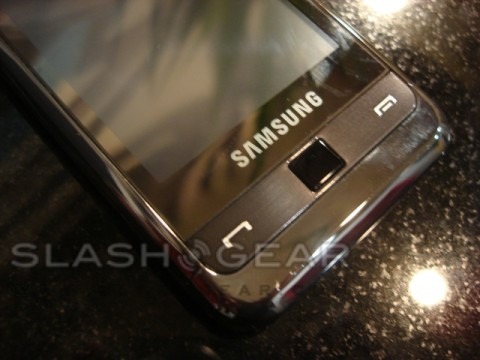
On the side is where you will find all of the control keys such as volume and a dedicated camera button. On the left there is a lanyard loop and the Samsung proprietary charging and headphone jack. This loop is where you would hang the included stylus if you so choose. The right side bears the notes button, up and down volume keys and a dual-action camera key that allows you to depress slightly to use autofocus and all the way to snap a picture. There is a sleep/power button located on the top of the device in the same place you would find it on the iPhone. Also on the top is a recessed reset button. All of the keys on the Samsung Omnia have what you might call a premium feel to them, every one has a very user friendly location and is placed right where you would expect them to be found.
When you flip the device over, your eyes are drawn from the smooth plastic back to the 5-megapixel camera, LED flash and vanity mirror for snapping pictures of yourself. Sliding off the back cover to reveal the battery is quite easy. Here you will find that in order to swap microSD or SIM cards you must first remove the battery. Generally we prefer an external or at least simpler way to swap cards; it's much easier to access the memory card from an external side port. Hopefully users won't have much cause to use a microSD card what with the 8 or 16GB of internal memory. If that's not enough space though you can purchase a 32GB microSD for a grand total of 48GB of storage.
The Samsung Omnia runs Windows Mobile 6.1 Pro with the TouchWiz user interface. We are still torn between TouchWiz and TouchFLO 3D found on the HTC Touch Pro. Much like the iPhone and identical to the Behold there is a "Dock" lining the bottom of the screen which houses the basic phone functions such as the dialer, phone book, web and menu shortcuts. A convenient slide-out menu hugs the left-hand side of the screen, with various shortcut buttons that users may drag and drop onto the customizable home screen. You can even arrange the icons in the menu in whichever order you like for even quicker access.
Icon placement on the home screen does not follow the grid-like placement of the iPhone. Instead they can be placed wherever you like, even overlapping each other. The top of the screen is occupied by the traditional Windows Mobile header that you would normally see. The home screen icons are a little larger than you would expect, making it easier to make the correct selection. One shortcut icon that we absolutely loved was the interactive photo frame. You can set whichever photo you like to be displayed and even quickly flip through photos without going into the album itself.
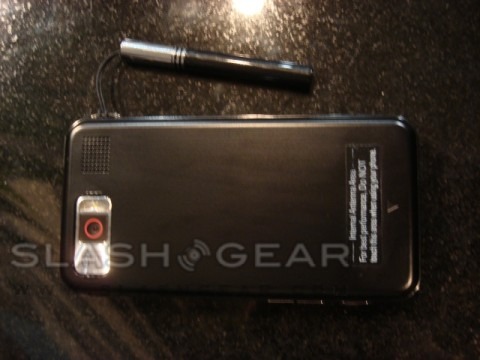
The built-in accelerometer responds very quickly when flipping the handset from portrait to landscape mode. There is very little transition time when an application is open. For whatever reason it does not allow you to flip the device upside down, not that you would have any need to. We are not sure if this is because of the hardware or software limitations of the device. The built-in GPS is severely limited to the VZNavigator application. Verizon has a tendency to severely limit their phones in a number of ways greatly compromising their potential.
Placing calls with the dialer is quite easy, the keys are laid out very well with plenty of room for your fingers. Searching through the contacts resembles the iPhone: on the right hand side you will find a scroll bar with the letters of the alphabet on them for quick searching. The large font in the phone book makes contacts very easy to read. Call quality was always top notch with very few dropped calls, and even when using Bluetooth headsets of various kinds we did not experience a loss in call quality. The speakerphone, however, left something to be desired. The sound was really crisp with a good tone, but the volume was always low, often too low to really make use of. The Omnia managed to last through an entire day of moderate use without dying on us. The included 1440mAh battery managed around 5 hours of talk time. Samsung quote up to 500 hours of standby time depending on conditions.
Samsung managed to keep this handset very clean and straightforward. There are virtually no programs preloaded on the device allowing users to have only the applications that they wish to download, eliminating bloat. There is a search application that allows you to explore files on your phone much like you would do on a PC.
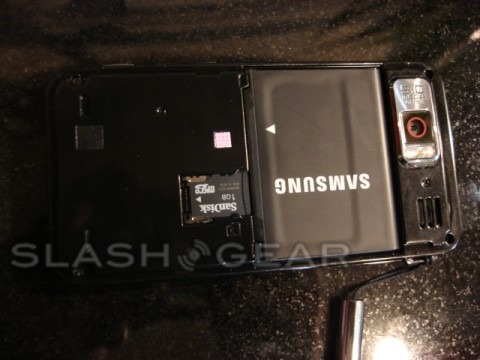
The Omnia's on-screen keyboard variants all work surprisingly well. For single-handed portrait typing you can use the traditional T9 input method. Flipping the handset into landscape mode will instantly trigger the accelerometer and allow you to use the full QWERTY keyboard. This keyboard is very well laid out for use with your thumbs. We found the Omnia not nearly as quick to type with as the iPhone; we blame this on the resistive touchscreen. As you type on the keyboard you will get visual confirmation of the key press. While this is generally a good thing, the confirmation is to the left or right of the key itself, rather than above the keys as seen on the iPhone, and as such your finger can often block it. As with the Samsung Behold there is a box that pops up trying to predict what you are trying to type. This box is more bothersome than it is useful; it will pop up and reformat the text to wrap around itself. We grew sick of this rather quickly because it is very hard to follow what your saying when the text keeps moving.
The browser is one place that the Samsung Omnia takes a clear lead over the Behold. The included app is a customized version of the yet-to-be-released Opera Mobile 9.5 that is powered by Opera Mini's Presto engine. Tabbed browsing is quick and rendered perfectly in full HTML. Scrolling around the page with your finger is made easier with a popup "map" of the current page. Much like the iPhone, a double tap will either zoom in or out on the selected area. One very unique and useful feature is the zoom out control, just run your finger along the right side of the display. The browser neatly auto formats the text on a web page to fit the zoomed in screen so that you do not have to scroll back and forth all the time.
Now to the camera, this is one of the first Windows Mobile phones with a 5-megapixel camera. You can take great photos with auto-focus and flash. Unlike many new phones, such as the Touch Pro or the T-Mobile G1, the camera operates really quickly especially with the autofocus. On-screen buttons include Video Camera, Focus, Exposure, Scenes, Flash, Shot Mode, Album and Resolution. Other available settings include, Sharpness, ISO Sensitivity, Color, Contrast, Focus Mode, Compression, White Balance and Saturation.
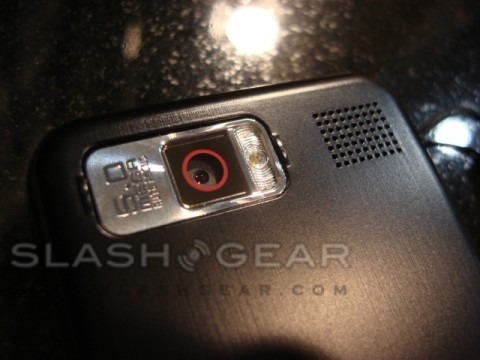
Despite all the megapixels, we didn't have the best experience with taking photos; for example, outside photos were saturated with color. The tone of the photo did not look very good. Indoor photos were not much better, lacking crispness, and lighting never favored the photo, even with help from the flash. Macro mode however surprised us; the flash dims itself according to the lighting conditions. We were not able to take really close photos however; the autofocus could never seem to get a good lock on the subject. Recording video can be done in MPEG4 format with up to 640 x 480 resolution at 15 frames per second. The sound comes out pretty clear, but the 15fps just doesn't seem to do it justice and videos always come out choppy.
The Samsung Omnia has a built-in FM radio tuner, with room for 6 different presets of your choosing. Interestingly enough they decided to include a record feature in this application so you can listen to songs whenever you like. Video quality, meanwhile, seemed stunted by the Windows Mobile limit of 65K colors making the transition poor at times. Samsung has made sure to get the word out that this handset is the first to support DivX/XviD file formats. Other formats supported include MP4, WMV, OGG and AMR.
We also found this very interesting Vaja Leather case that goes with the overall style of the Omnia well. Starting at $75 you can personalize your case by choosing from 40 different soft tones for the exterior and interior of the case. Even add text or a graphic to make this case all your own. If you wish to have a belt holster that's no problem, it will only cost you $5 extra. The case protects your screen from unwanted scratches while allowing access to your external keys such as the volume and camera key.
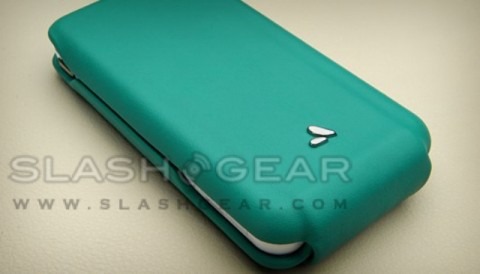
Overall the Samsung Omnia is one of the smoothest running Windows Mobile phones on the market today. We had no issues with lag, even with several apps loaded. This was certainly one of the most fun phones to review as of late. The Omnia has restored our faith in Windows Mobile phones after playing with the HTC Touch Pro and TouchFLO 3D.
The Omnia has lived up to the saying "A truly all-in-one phone." The Omnia takes the best of Windows Mobile 6.1 Professional and TouchWiz to make the users' experience very enjoyable. Every feature from the camera to browsing the Internet works very well. There is no area that the Omnia falls short in. This device delivers all of the features of a smartphone without being overwhelming to first time users.
We would recommend this phone to anyone who loves to take pictures. The picture quality may not be top notch, but it nice shots in comparison to other 5-megapixle smartphones. Photographers will find the large amount of internal storage space more than enough for snapping photos on the go. The Samsung Omnia will be available at Verizon Wireless locations on December 8th for $249.99, when you sign a two-year agreement.
]
